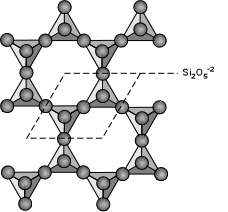
| EENS 2110 |
Mineralogy |
| Tulane University |
Prof. Stephen A. Nelson |
|
Phyllosilicates (Micas, Chlorite, Talc, & Serpentine) |
|
|
|
|
Phyllosilicates (Sheet Silicates) The phyllosilicates, or sheet silicates, are an important group of minerals that includes the micas, chlorite, serpentine, talc, and the clay minerals. Because of the special importance of the clay minerals as one of the primary products of chemical weathering and one of the more abundant constituents of sedimentary rocks, they will be discussed in more detail in the next lecture. |
| The basic structure of the phyllosilicates is based on interconnected six member rings of SiO4-4 tetrahedra that extend outward in infinite sheets. Three out of the 4 oxygens from each tetrahedra are shared with other tetrahedra. This leads to a basic structural unit of Si2O5-2. |  |
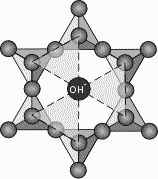 |
|
| The octahedral layers take on the structure of either Brucite [Mg(OH)3],
if the cations are +2 ions like Mg+2 or Fe+2, or
Gibbsite [Al(OH)3], if the cations are +3 like Al+3.
In the brucite structure, all octahedral sites are occupied and all
anions are OH-1. In the Gibbsite structure every 3rd
cation site is unoccupied and all anions are OH-1. |
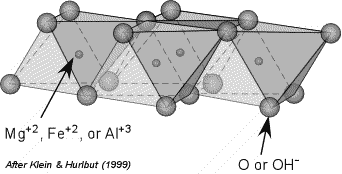 |
This gives rise to 2 groups of sheet silicates:
We can build the structures of the various sheet silicates by starting with the octahedral layers similar to the structures of brucite or gibbsite, as shown below. |
| The trioctahedral phyllosilicates are based on the structure where the
octahedral layers are similar to brucite, where Mg+2 occupies
the cation position.
The dioctahedral phyllosilicates are based on the structure where the octahedral layers are similar to gibbsite, where Al+3 occupies the cation position. |
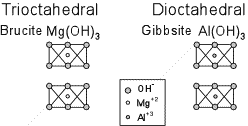 |
| The octahedral sheets in both cases are held together by weak Van der Waals bonds. |
| If we start with the brucite and gibbsite structures shown above, and replace 2 of the OH ions with O, where the Oxygens are now the apical Oxygens of the tetrahedral sheets, then we get the structure of the serpentine mineral, Lizardite, if the octahedral layer is trioctahedral, containing Mg+2. If the octahedral layer is dioctahedral, containing Al+3, the structure of the clay mineral Kaolinite, is obtained. | 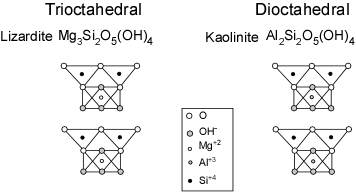 |
This leads to a tetrahedral - octahedral (T-O) structure, where each T-O layer is bonded to the top (or bottom) of another T-O layer by Van der Waals bonds. |
| If 2 more of the OH ions in the octahedral layer are replaced by O, and these O become the apical Oxygens for another tetrahedral layer, the this builds the trioctahedral phyllosilicate talc or the dioctahedral pyrophyllite. This becomes a T-O-T layer that can bond to other T-O-T layers by weak Van der Waals bonds. | 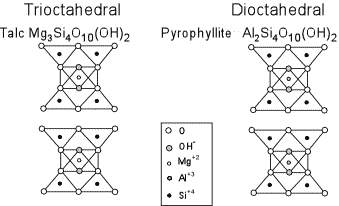 |
If an Al+3 is substituted for every 4th Si+4 in the tetrahedral layer, this causes an excess -1 charge in each T-O-T layer. To satisfy the charge, K+1 or Na+1 can be bonded between 2 T-O-T sheets in 12-fold coordination. |
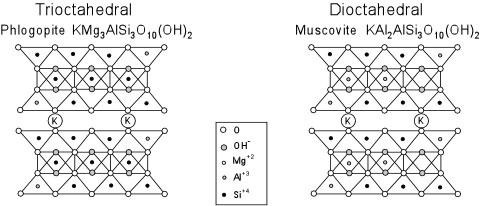 |
For the trioctahedral sheet silicates this becomes Phlogopite (Mg-biotite), and for the dioctahedral sheet silicates this becomes Muscovite. This makes a T-O-T - T-O-T layer that, again can bind to another T-O-T - T-O-T layer by weak Van der Waals bonds. It is along these layers of weak bonding that the prominent {001} cleavage in the sheet silicates occurs. Replacing 2 more Si+4 ions with Al+3 ions in the
tetrahedral layer results in an excess -2 charge on a T-O-T layer, which
is satisfied by replacing the K+1 with Ca+2. |
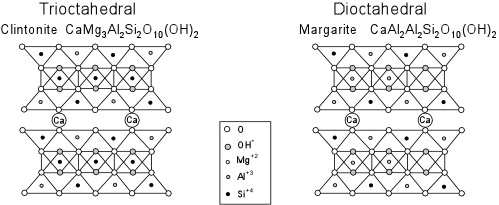 |
This results in the trioctahedral sheet silicate - Clintonite and the dioctahedral sheet silicate - Margarite. Because of the differences in charge balance between the trioctahedral and dioctahedral sheet silicates, there is little solid solution between the two groups. However, within the trioctahedral sheet silicates there is complete substitution of Fe+2 for Mg+2 and limited substitution of Mn+2 into the octahedral sites. Within the dioctahedral sheet silicates there is limited substitution of Fe+3 for Al+3 in octahedral sites. In addition, F- or Cl- can substitute for (OH)- in the hydroxyl site. As previously discussed, substitution of F-1 stabilizes the mineral to higher pressures and temperatures. |
| Another group of phyllosilicates that is more of mixture of structural types is the chlorite group. Although chlorite is complex in that the amount of Al that can substitute Mg and Si is variable, one way of looking at the chlorite structure is shown below. |
| Here, the chlorite structure is depicted as consisting of a brucite-like layer (with some Al) sandwiched between tetrahedral layers that are similar to phlogopite. | 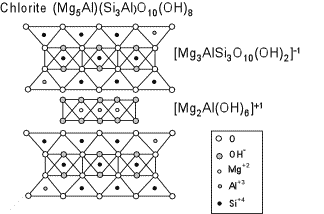 |
| Another important sheet silicate structure is that of vermiculite. This
is similar to the talc structure, discussed above, with layers of water
molecules occurring between each T-O-T layer.
Similarly, insertion of layers of water molecules between the T-O-T sheets of pyrophyllite produces the structure of smectite clays. The vermiculite and smectite groups are therefore expanding type sheet silicates and as the water is incorporated into the structure the mineral increases its volume. Although we have shown that the octahedral layers fit perfectly between the tetrahedral layers, this is an oversimplification. If the tetrahedral layers were stacked perfectly so that apical oxygens were to occur vertically aligned, then the structure would have hexagonal symmetry. But, because this is not the case, most of the phyllosilicates are monoclinic. |
| Serpentine Group
The serpentine group of minerals has the formula - Mg3Si2O5(OH)4. Three varieties of serpentine are known. Antigorite and Lizardite are usually massive and fine grained, while Chrisotile is fibrous. As discussed above, the imperfect fit of the octahedral layers and the tetrahedral layers causes the crystal structure to have to bend. |
| In Antigorite the bending of the sheets is not continuous, but occurs in sets, similar to corrugations, as shown here. |  |
| In Chrisotile, the bending of the sheets is more continuous, resulting in continuous tubes that give the mineral it's fibrous habit. The Chrisotile variety is commonly referred to as asbestos. | 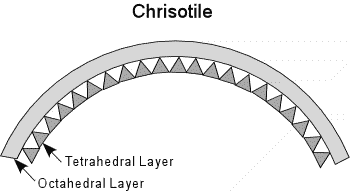 |
| Occurrence - Serpentine is found as an alteration product of
Mg-rich silicates like pyroxene and olivine. It results due to
hydration. For example:
Thus, serpentine is commonly found pseudomorphed after olivines and pyroxenes in altered basic and ultrabasic igneous rocks, like altered peridotites, dunites, and sometimes basalts and gabbros. It is commonly associated with minerals like magnesite (MgCO3), chromite, and magnetite. If the rock is made up almost entirely of serpentine, it is called a serpentinite. Properties - Because the serpentines usually occur either as fine-grained aggregates or fibrous crystals, optical properties are difficult to determine. Most of the time, serpentine can be distinguished by its characteristic pseudomorphing of other crystals like olivines and pyroxenes. In hand specimen it generally tends to have a dark green color with a greasy luster. In thin section it is clear to pale green to pale yellow, but does not show pleochroism, shows a generally low relief compared to minerals like olivine and pyroxene with which it is associated, and show very low order interference colors due to its low birefringence. |
| Talc
Talc has the chemical formula - Mg3Si4O10(OH)2. It is probably best know for its low hardness. Although it has a micaceous structure, it is so easily deformed, that crystals are rarely seen. Occurrence - Like serpentine, talc requires an environment rich in Mg. It is therefore found in low grade metamorphic rocks that originated as ultrabasic to basic igneous rocks. Rocks composed almost entirely of talc have a greasy feel and are referred to as soapstone. Properties - Talc is most easily distinguished in hand specimen by its low hardness, greasy feel, and association with other Mg-bearing minerals. When crystals are present they show the characteristic micaceous cleavage on {001}. In thin section, talc is colorless, biaxial negative with a 2V of 0 to 30o. Like other sheet silicates, it shows the well developed {001} cleavage. Maximum interference colors, consistent with a birefringence of 0.05 is 3o yellow. Muscovite has a higher birefringence and higher 2V, properties which easily distinguish the 2 minerals. |
| Mica Group
The micas can be divided into the dioctahedral micas and the trioctahedral micas, as discussed above. Muscovite, Paragonite, and Margarite are the white micas, and represent the dioctahedral group, and Biotite and Clintonite (Xanthophyllite) the black or brown mica, represents the trioctahedral group. Muscovite and Biotite are the most common micas, but the Lithium- rich, pink mica, Lepidolite, K(Li,Al)2AlSi3O10(OH)2 is also common, being found mostly in pegmatites. Muscovite Muscovite, KAl3Si3O10(OH)2, and Paragonite, NaAl3Si3O10(OH)2, are two potential end members of the solid solution series involving K and Na. But, there is a large miscibility gap between the two end members with Muscovite being between 65% and 100% of K-rich end member, and Paragonite showing compositions between about 80% and 100% of the Na-rich end member. Occurrence - Muscovite is common constituent of Al-rich medium grade metamorphic rocks where is found in Al-rich schists and contributes to the schistose foliation found in these rocks. Muscovite is also found in siliceous, Al-rich plutonic igneous rocks (muscovite granites), but has not been found as a constituent of volcanic rocks. In these rocks it is commonly found in association with alkali feldspar, quartz, and sometimes biotite, garnet, andalusite, sillimanite, or kyanite. Properties - Muscovite is easily identified in hand specimen by its white to sometimes light brownish color and its perfect {001} cleavage. In thin section, the {001} cleavage is easily seen and it's high birefringence is exhibited by the large change in relief on rotation of the stage and it's 2nd to 4th order interference colors. It is clear and shows no pleochroism (which distinguishes it from Biotite), and it is biaxial negative with a 2V between 28 and 50o. One of the most diagnostic properties of the micas, including muscovite, is the mottled or birds-eye extinction exhibited by these minerals.
|
|
Biotite Biotite is a solid solution between the end members Phlogopite KMg3AlSi3O10(OH)2 and Annite KFe3AlSi3O10(OH)2, although pure Annite does not occur in nature. In addition, small amounts of Na, Rb, Cs, and Ba may substitute for K, and like in other minerals, F can substitute for OH and increase the stability of Biotite to higher temperatures and pressures. Occurrence - Nearly pure phlogopite is found in hydrous ultrabasic rocks like kimberlite, and is also found in metamorphosed dolomites. Biotite, with more Fe-rich compositions is common in dacitic, rhyolitic, and trachytic volcanic rocks, granitic plutonic rocks, and a wide variety of metamorphic rocks. In metamorphic rocks, biotite usually shows a preferred orientation with its {001} forms parallel to the schistose foliation. Properties - In hand specimen, Biotite is brown to black and shows the perfect {001} micaceous cleavage. In thin section, it shows the perfect cleavage and mottled extinction typical of all micas. It's most characteristic property is its pleochroism, showing yellow to brown to green colors. Hornblende shows similar pleochroic colors, but is distinguished from biotite by the differences in cleavage of the 2 minerals. Biotite is biaxial negative with a low 2V of 0o to 25o. |
| Chlorite Group
As discussed above, the Chlorite group has a structure that consists of phlogopite T-O-T layers sandwiching brucite-like octahedral layer. There is substantial substitution of Mg for Fe, and Al can substitute for (Mg, Fe) in both the octahedral sites, as well as for Si in the tetrahedral sites. Thus, chlorite can have a rather complicated formula - (Mg,Fe,Al)3(Si,Al)4O10(OH)6. Occurrence- Chlorite is a common mineral in low grade metamorphic rocks, where it occurs in association with minerals like actinolite, epidote, and biotite. It also forms as an alteration product of pyroxenes, amphiboles, biotite, and garnet in igneous as well a metamorphic rocks. Properties - In hand specimen, chlorite is recognized by its green color, micaceous habit and cleavage, and association with other minerals like actinolite and epidote. In thin section, Chlorite shows low relief and low birefringence, with a characteristic midnight blue to black anomalous interference color. It shows some pleochroism in the range of green to pale yellow. It is easily distinguished from biotite by its lower relief and anomalous interference color. Examples of questions on this material that could be asked on an exam (note that properties that distinguish different minerals will be included in the laboratory exam)
|